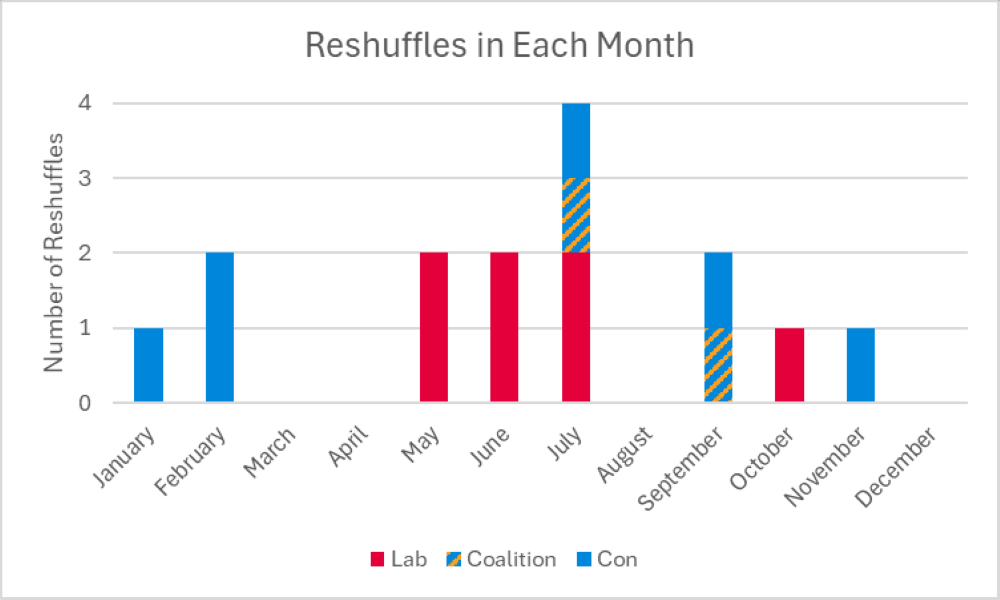When will Keir Starmer do his Cabinet reshuffle?
4 min read
It looks like a government reshuffle is coming. But what does the data tell us about when exactly it will be?
I remember reshuffle days. I was once offered two jobs in the same reshuffle by Tony Blair. I also once found that I was changing roles (upwardly) when I called my ministerial office from inside the Division Lobby to hear the person who had until then been my private secretary greet me in the name of their new minister.
The truth is that no one in government enjoys reshuffle day. There are never enough posts to placate all those who believe they are the solution to a government’s problem. And no prime minister savours sacking members of their team. New ministerial teams take time to bond, special advisers are sacked, and new ones are hired. Indeed, insiders recently told PoliticsHome that the Labour leader is not a big fan of reshuffles. All of this means that it can make sense to have fewer, but bigger, reshuffles.
Speculation about Keir Starmer’s first full-scale Cabinet reshuffle has been circulating at Westminster for months. Some commentators forecast that the Prime Minister would reshuffle his Cabinet in April; others suggested that the shake up might take place in June or July following anticipated ministerial resignations in the wake of the Commons vote on the Welfare Bill; a report in The Times recently predicted that the reshuffle will come in September to allow Starmer to “reassert his authority”.
Arden’s new analysis of data on the timing of past major reshuffles has identified some striking trends. (For the purposes of the research, we have defined ‘major reshuffles’ as those involving at least five Cabinet-level changes).
Since Margaret Thatcher in 1979, prime ministers have carried out their first major reshuffle an average of 407 days after entering office. If his timing was exactly in line with that average, Starmer would have completed his first major reshuffle last weekend.
 When have major Cabinet reshuffles taken place since 1997? (Arden Strategies)
When have major Cabinet reshuffles taken place since 1997? (Arden Strategies)
Yet there’s one very good reason it wasn’t last weekend. Our data also suggests Cabinet reshuffles rarely happen in August because so many of those hired/fired are on holiday with their families, and less easy to contact, even for the fabled Downing Street switchboard.
Since Blair became prime minister in 1997, no major Cabinet reshuffle has taken place in August. The most common month for reshuffles over that time has been July. That is often the kindest time of year to let ministers down gently. After being fired, disappointed ministers don’t have to be in Westminster for long before the recess gets underway. They can lick their wounds away from the glare of media attention.
Our analysis of major reshuffles since 1997 also shows a divergence in reshuffle timing along party lines. Conservative Cabinet reshuffles most often took place in autumn or winter, while Labour reshuffles were carried out in spring or summer.
Labour governments have also tended to have less frequent major reshuffles than Conservative-led administrations over the period covered by the data. While Labour prime ministers left an average of 567 days between reshuffles, the figure for Conservative premiers has been 441 days. Overall, the frequency of reshuffles has steadily increased since 1997, as this graph shows. The quixotic nature of personnel changes in the most recent Conservative governments partly explains this.
As leader of the opposition, Starmer was ruthless in sacking shadow ministers. Many Labour insiders expect the Prime Minister to show the same ruthlessness when carrying out his first Cabinet reshuffle.
With MPs due back at Westminster in less than a fortnight, the speculation can be expected to build again. Even within Downing Street, few will know for certain when Starmer plans to carry out his first reshuffle.
Jim Murphy is the Founder of Arden Strategies and a former Cabinet minister.
